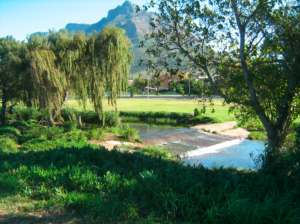Introduction
There are two main freshwater features within the Two Rivers Urban Park (TRUP), namely the Liesbeek and the Black River. Biologically sensitive wetland areas and areas of high faunal sensitivity status comprising remnant and artificial floodplains form an important ecological system, that is worth being maintained to protect endangered species [3]. The LLPT (Liesbeek Leisure Properties Trust) is proposing to redevelop the River Club property which is situated in TRUP area and portions of adjacent properties, including among others, portions of the original course of the Liesbeek River and Liesbeek Canal for commercial, retail, resi- dential, institutional and associated uses. SRK Consultancy ®(South Africa) assessed the impact of the pro- posed redevelopment on among others, the potential Surface Water Hydrology for both the Liesbeek and the Black River and surrounding areas [11, 12, 10]. These floodplains are deemed crucial for flood prevention and for Cape Town to become a water sensitive city. This report focuses on the development of the original Liesbeek River run. Currently, the Old Liesbeek section offers relatively poor habitat support because it is not being managed effectively and is not being replenished by freshwater from the Liesbeek. However, the original Liesbeek River channel falls under the definition of a water body according to the National Water Act No. 36 from 1998 [26]) and therefore governmental water protection regulations apply. By law it is prohib- ited to build within 30 meters proximity to a water body. Therefore, the consulting company SRK proposes a Corridor Alternative where it is intended to fill in the original Liesbeek River channel. This report outlines an alternative position to the one that is offered by the SRK consultants and advises that the island concept on which the River Club property stands should by maintained and that the old Liesbeek River channel should be reestablished as a flowing water body. Filling up the original Liesbeek River channel would have negative impacts on seasonal flooding, ecology and the water quality.
Skip to content


